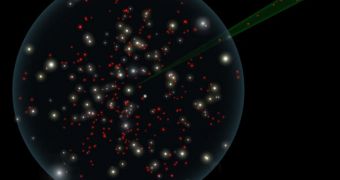A group of investigators recently announced the discovery of the coolest known group of brown dwarfs. This is a very special class of stellar objects, experts say, given that they are produced just like stars, but fail to ignite completely. For many years, the international astronomical community has been struggling to come to an agreement regarding how to best classify these objects. Some say they are very large gas giants, whereas others argue they are stars. The new finding is bound to reignite the controversy, Space reports.
According to existing theories, stars form inside nebulae. These are colloquially known as stellar nurseries, and are basically large accumulations of hydrogen gas and cosmic dust clouds. Due to gravitational interactions inside these materials, smaller clouds separate themselves within the large one. The little ones grow in time, accumulating more and more hydrogen, until finally a threshold is reached. Once this happens, the entire structure begins to collapse in on itself, igniting in the process, and giving birth to a young star.
When brown dwarfs form, astronomers say, this process fails. The experts believe that the collapsing clouds of gas and dust fail to ignite properly. This means that the resulting object is incapable of supporting nuclear fusion on its own – and this is widely considered to be a hallmark of all stars. In a study detailed in the latest issue of the esteemed Astronomical Journal, experts from the American space agency say that a group of 14 dwarfs were recently found using the NASA Spitzer Space Telescope. The objects all have temperatures ranging between 350 and 620 degrees Fahrenheit (177 and 327 degrees Celsius), which makes them incredibly cold. The Sun, for example, has an average surface temperature of about 5,500 degrees Celsius.
This new group of brown dwarfs is therefore colder even than Mercury, which has a fiery surface and atmosphere. The 14 objects are located several hundreds of light-years away from the Earth, and this implies that they cannot be observed using optical wavelength telescopes, or ground-based observatories. Only infrared instruments such as Spitzer and the Wide-field Infrared Survey Explorer (WISE) are sufficiently sensitive to allow for such studies.
“WISE is looking everywhere, so the coolest brown dwarfs are going to pop up all around us. We might even find a cool brown dwarf that is closer to us than Proxima Centauri, the closest known star. WISE is going to transform our view of the solar neighborhood [a 25 light-years radius around the Sun]. We'll be studying these new neighbors in minute detail – they may contain the nearest planetary system to our own” explains the lead author of the new study, WISE project scientist Peter Eisenhardt. He is based at the NASA Jet Propulsion Laboratory (JPL) in Pasadena, California.

 14 DAY TRIAL //
14 DAY TRIAL //